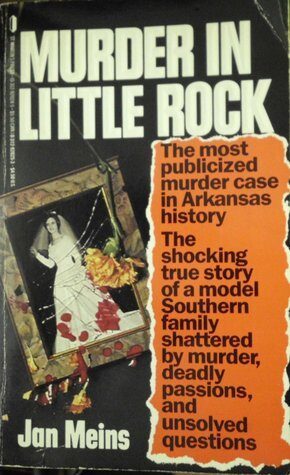
Jan Meins’s Murder in Little Rock takes readers deep into the heart of Arkansas, unraveling a shocking true crime tale that left an indelible mark on Little Rock’s history. Known as “one of the most publicized murder cases in Arkansas,” the story dissects the implosion of a seemingly idyllic Southern family and the dark motivations behind a heinous act. Through meticulous research and storytelling, Meins delivers a gripping account that is both chilling and thought-provoking.
Plot Overview
The narrative focuses on the violent demise of a respected individual in Little Rock, an event that not only shattered the illusion of familial harmony but also brought to light layers of deceit, passion, and deadly intentions. As investigations proceed, the story exposes an intricate web of lies and manipulations. At its core is a family dynamic riddled with dysfunction—hidden beneath the veneer of societal respectability.
The murder was not an impulsive act but one steeped in premeditation and emotional unrest. Meins vividly reconstructs the timeline, from the initial discovery of the crime scene to the exhaustive legal proceedings that followed. Readers are thrust into the gripping realities of forensic investigations, media scrutiny, and the psychological unraveling of those involved.
Themes Explored in Depth
1. The Fragility of Appearances
At first glance, the family at the center of the story seems like the embodiment of Southern charm and tradition. However, as Meins delves deeper, it becomes clear that appearances can be deceiving. The narrative serves as a stark reminder of how carefully curated images can mask internal chaos.
2. Crime and Consequences
The book unflinchingly examines the ripple effects of a single violent act. From the victim’s immediate circle to the broader community, the consequences of the crime extend far beyond its perpetrator and victim.
3. The Media’s Role in Justice
A central critique in the book is the role of media sensationalism. Meins scrutinizes how public perception, often fueled by biased or incomplete reporting, can complicate the pursuit of justice.
4. The Pursuit of Truth
Through its focus on the trial and investigative process, the story emphasizes the painstaking efforts required to uncover the truth. It raises questions about the reliability of witnesses, the integrity of legal strategies, and the moral ambiguities inherent in high-stakes cases.
Detailed Analysis of the Writing
Jan Meins’s prose combines the precision of investigative journalism with the emotional resonance of a seasoned storyteller. Her attention to detail is evident in her vivid descriptions of courtroom exchanges, forensic breakthroughs, and personal reflections of those involved. This approach not only educates readers about the complexities of the legal and criminal justice systems but also draws them into the human drama that underpins the case.
The pacing of the narrative mirrors the tension of a murder investigation, keeping readers on edge as the story unravels layer by layer. Meins’s ability to transition seamlessly between the factual and the emotional realms ensures that the book resonates with a wide audience, from true crime aficionados to casual readers.
Key Characters and Their Roles
- The Victim: Presented as a beloved figure within the community, the victim’s life and untimely death are central to understanding the profound impact of the crime.
- The Perpetrator(s): Through detailed psychological portraits, Meins delves into the minds of those responsible, exploring their motives and the series of decisions that led to the tragedy.
- Law Enforcement and Legal Teams: The investigators and lawyers are portrayed as both heroes and flawed individuals, highlighting the challenges and triumphs of seeking justice.
- The Family and Community: The ripple effects of the murder are shown through the lens of grieving family members and a shocked community struggling to reconcile the crime with their perceptions of those involved.
Praise
Murder in Little Rock has garnered acclaim for its meticulous research and gripping narrative. Readers frequently commend Meins for her ability to humanize the individuals involved while maintaining a firm grasp on the factual elements of the case. The book has been celebrated for shedding light on a lesser-known case with universal implications.
Criticism
Some readers have expressed concerns over the detailed focus on legal minutiae, suggesting it occasionally detracts from the broader narrative. Others feel that the emotional toll on secondary characters, such as extended family members and community figures, could have been explored further.
The Legacy of the Case
The murder chronicled in Murder in Little Rock remains a haunting chapter in Arkansas’s history. Beyond its immediate tragedy, the case serves as a cautionary tale about unchecked passions, the fragility of human relationships, and the devastating consequences of violence.
Read the Full Novel Here
Murder in Little Rock by Jan Meins | Goodreads
About Jan Meins
Jan Meins is a renowned true crime author known for her investigative rigor and compelling storytelling. Her works often focus on unraveling the complexities of criminal cases while giving voice to the human stories behind the headlines. With Murder in Little Rock, Meins cements her reputation as a masterful chronicler of real-life drama, blending factual accuracy with an empathetic approach to storytelling.
Explore Related Ebook Novels
- Murder in Little Rock by Jan Meins | Goodreads
- Read The Man in the Rockefeller Suit, A Novel by Mark Seal
- A Tangled Web of Deception: Unveiling John Grisham’s “Twisted Ties”
- Read The Italian Boy, A Novel by Sarah Wise


